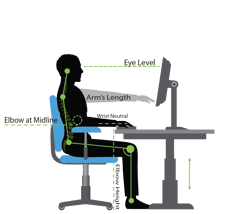When it comes to office work, the term “ergonomics” is not new. You’ve probably heard the term for years now and may even have some “ergonomic” equipment in your office. But do you really understand what “ergonomics” means when it comes to your office setup and why having a proper ergonomic work environment is key to reduced muscle discomforts?

What is Ergonomics?
According to the Oxford Dictionary, ergonomics is “the study of people’s efficiency in their working environment.” This means ergonomics comes into play when considering:
- How your office is arranged
- How your furniture is designed
- Your body posture when working
Considering ergonomics when you are working in your office space allows for a reduction in awkward postures or repeated movements if your area is set up properly. When it comes to creating a proper ergonomic workspace, you are looking to create an environment that maximizes your efficiency when interacting with people and things while reducing your exposure to risky movements and positions.
How do you Create an “Ergo-Friendly” Work Environment?
According to recent research published in Forbes Magazine, the normal office worker sits for an astounding 15 hours per day. And if a person has a long commute, this number grows even higher. These high rates of sitting lead to an increased risk of obesity, high blood pressure, high cholesterol, stroke, and heart disease not to mention numerous musculoskeletal injuries such as discomforts to the neck, shoulders, and back along with eye strain and Carpel Tunnel Syndrome.
While setting up your office in an ergonomic friendly manner won’t combat the cardiovascular concerns of the sedentary lifestyle sitting for 15 hours per day can bring, it will help reduce the risk of musculoskeletal injury.
Below are four steps you can take to create a more ergonomically correct work area.
Adjust Your Seating to Work in a Neutral Position
The body functions best when we work with a neutral spine. This simply means working in a position that comfortably aligns all of your joints. When working in neutral, your body has less stress on your muscles, tendons, and skeletal system which reduces the risk of developing musculoskeletal discomfort.
To operate in neutral, you want to keep your body long and aligned. To do this, create an “L” position with your body. This can be achieved by:

- Keeping your head directly above your shoulders not tilting forward, backward, or to the side.
- Aligning hips slightly above knees to form a 110-degree angle. This will take the pressure off of your bones.
- Create a 90-degree bend in your knees to support your upper body. Knees should be 2”-3” off the front of your chair when sitting. (Think approximately 3 finger-width gap)
- Place feet flat on the floor. If your chair is too high, adjust down if possible. If not adjustable, use a flat stole to place your feet on.
There are a wide variety of office environments, and finding neutral can look different depending on what type of space you work in. Download our free “Finding Neutral at the Office or Home” how-to guide for assistance in creating a neutral work environment for both sitting and standing desks.
Set Up your Desk so Everything is Within Arm’s Reach
Avoiding awkward positions is a big piece to creating an ergo-friendly workspace. When you put your body in awkward positions or deviate significantly from the neutral position, your muscles operate less efficiently and require you to expend more force to complete the task. This additional force and decreased efficiency can result in musculoskeletal injury. To avoid awkward positions such as bending, reaching, lifting, and twisting, you want to keep what you’re working on close to you. Specifically, you want to set up your desk are so what you are working on is within arm’s reach.
Modify Your Work Activities to Avoid Repetitive Motions
While this step has less to do with setting up your space physically, it has everything to do with setting up your workday schedule. A significant portion of work-related injuries happen over time and are caused by ongoing, repetitive movements. Those repetitive motions can be everything from typing, to answering the phone, to writing with a pencil. By themselves, those activities do not typically cause strain but when you do them over and over again, they can lead to stress and discomfort.
To avoid repetitive motions, switch tasks every hour. Frequently switching tasks encourages the use of an entirely different muscle group which will give time for your other muscles to recover while still maintaining your work productivity. Additionally, you can take advantage of some ergonomic tools such as headsets, adjustable monitors, and sit/stand desks reduce the risk of injury from repetitive motions.
